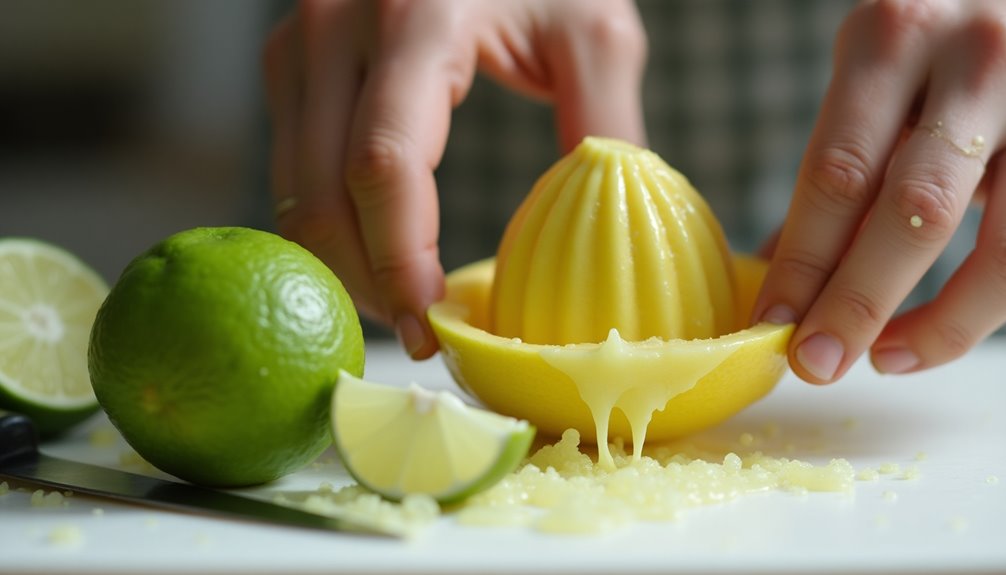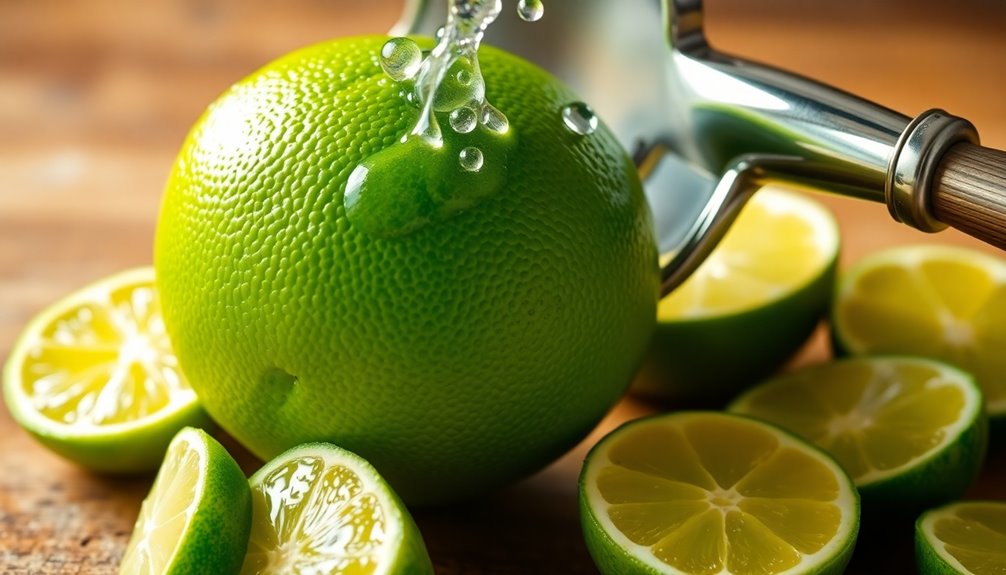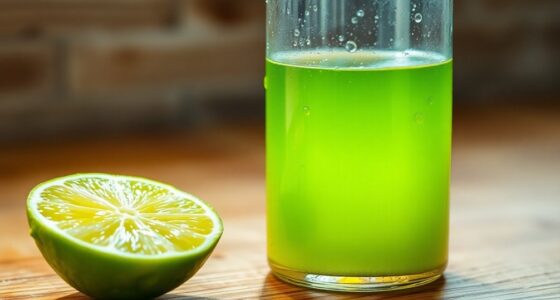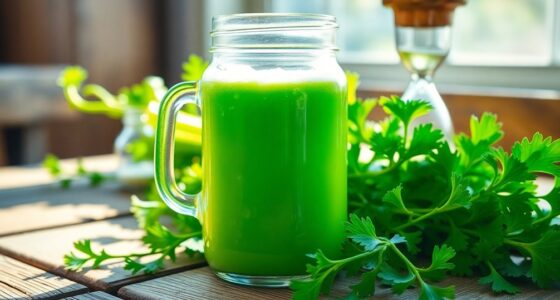To juice a key lime, start by selecting ripe ones that feel slightly soft and are vibrant green. Cut each lime in half on a slant to expose more pulp. For easier juicing, consider warming them in the microwave for 30 seconds. Use a garlic press with the cut side down to extract the juice. Strain through a fine mesh to remove pulp and seeds. This will give you smooth, flavorful juice. Want to know more tips? Keep going!
Key Takeaways
- Select fresh key limes that are slightly soft, vibrant green, and free of blemishes for maximum juice yield.
- Cut limes in half on a slant to expose more pulp, facilitating easier juicing.
- Warm the limes in the microwave for 30 seconds to soften them, making juicing easier.
- Use a garlic press with the cut side down for efficient juice extraction and minimal effort.
- Strain the juice through a fine mesh strainer to remove pulp and seeds, ensuring a smooth consistency.

Juicing a key lime is a breeze when you know the right techniques. Unlike regular lime juice, key lime juice boasts a unique tartness that can elevate your favorite dishes and cocktails. Whether you're whipping up a classic Key Lime Pie or simply adding a zesty kick to your recipes, extracting the maximum amount of juice from your key limes is essential. Let's explore how to do just that.
Start by selecting fresh key limes. They should feel slightly soft when you squeeze them, indicating ripeness. Next, cut each lime in half on a slant. This angle exposes more pulp and makes juicing easier. You want to get as much juice as possible, and this technique helps ensure you don't miss out on any liquid gold.
If you want to really maximize the amount of juice you extract, consider using a microwave. Pop the key limes in the microwave for about 30 seconds. This step softens the limes, making it easier to juice them. After warming them up, grab your garlic press. It might sound unconventional, but this handy kitchen tool is perfect for juicing key limes. Place the cut side down in the press, then squeeze. You'll be amazed at how much juice you can get out with minimal effort.
Once you've juiced the limes, it's time to filter out the pulp and seeds. Pour your freshly extracted key lime juice through a fine mesh strainer into a bowl or measuring cup. This step is crucial if you prefer a smoother consistency, which is especially important for recipes like Key Lime Pie. You don't want any unwanted bits getting in the way of that creamy filling!
Now that you have your key lime juice, you might be wondering how to store it. If you've juiced more than you need for one recipe, don't worry! You can store the juice in an airtight container in the refrigerator for about 2-3 days. This gives you some flexibility for using it in other dishes or drinks.
If you think you won't use it that quickly, consider freezing the juice. It can be kept frozen for 3-4 months, making it a great option for long-term storage. Just pour it into ice cube trays or freezer-safe containers, and you'll have key lime juice ready to go whenever you need it.
Now that you know how to juice key limes efficiently, you can enjoy their delightful flavor in your culinary creations. Whether you're adding a splash to a refreshing cocktail, dressing up a savory dish, or crafting the perfect Key Lime Pie, you'll appreciate the extra effort you put into juicing these little gems.
Frequently Asked Questions
What Is the Best Way to Juice a Key Lime?
When you're looking for the best way to juice a key lime, consider a few simple techniques.
First, slice the lime in half and try using a garlic press for maximum juice extraction. Make sure to cut it on a slant to expose more pulp. Press the cut side down for optimal yield.
If you want even more juice, microwave the limes for about 30 seconds before juicing.
Enjoy your fresh lime juice!
How to Juice Key Limes Without a Juicer?
You’ve got those tiny key limes, and you’re wondering how to get every drop of juice without a juicer. One of the simplest methods is to roll the tiny key limes on a hard surface, applying gentle pressure to break down the flesh inside. You can then cut them in half and squeeze them by hand, ensuring you capture every drop of that tart juice. If you’re familiar with how to juice a lemon, you can use the same technique for key limes and enjoy their zesty flavor in your recipes!
Here's the secret: slice them in half and grab a garlic press. It might sound odd, but trust me; it works wonders.
Press the cut side down, squeeze firmly, and watch the juice flow. For an even smoother finish, strain it to catch the pulp and seeds.
You'll be amazed at the results!
How Many Key Limes to Make 1 Cup of Juice?
To make 1 cup of juice, you'll need about 20 to 25 key limes.
These limes are smaller and have less juice than regular limes, so you'll require quite a few.
Keep in mind that the ripeness and freshness of the limes can affect the yield; fresher limes usually give you more juice.
If you're in a pinch, a mix of lemon and regular lime juice can mimic that unique key lime flavor.
What Can I Use if I Don't Have Key Lime Juice?
If you don't have key lime juice, you've got some great alternatives.
You can mix equal parts of lemon juice and regular lime juice for a similar flavor. Bottled key lime juice, like Nellie and Joe's, is another convenient option.
Freshly squeezed lime juice from regular limes works too, though it's not identical. In a pinch, bottled lemon juice will add tartness, and using lime zest can enhance the flavor in desserts.
Conclusion
Now that you've coaxed the vibrant essence from your Key limes, you've unlocked a treasure trove of zesty delight. With just a gentle squeeze, you've transformed those tiny gems into a burst of sunshine, ready to elevate your favorite dishes or beverages. So, as you bask in your citrusy creation, let the refreshing tang dance on your palate and brighten your day. You've not just juiced a lime; you've captured a little slice of paradise. Enjoy!
Cindy thoroughly researches juicing trends, techniques, and recipes to provide readers with practical advice and inspiration. Her writing style is accessible, engaging, and designed to make complex concepts easy to understand. Cindy’s dedication to promoting the advantages of juicing shines through her work, empowering readers to make positive changes in their lives through the simple act of juicing.











